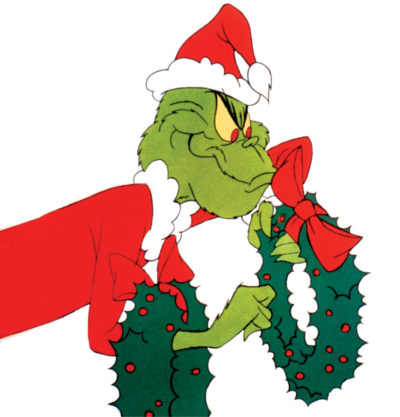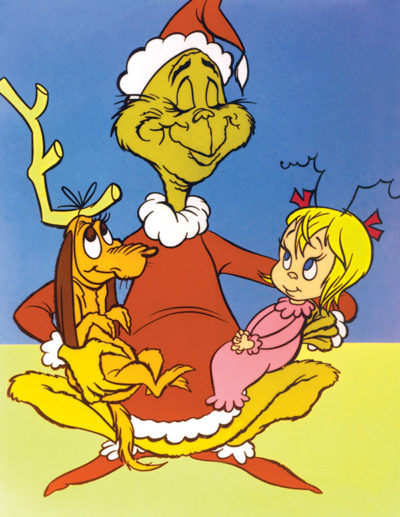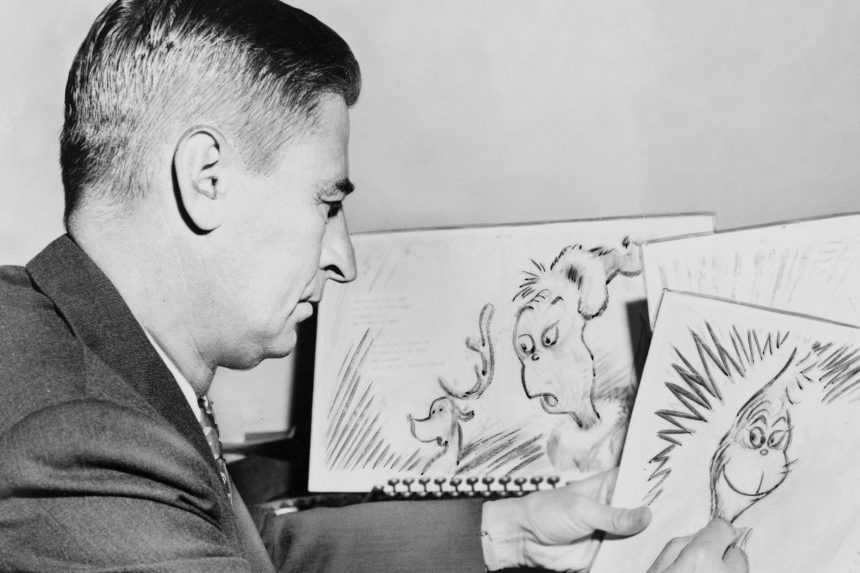
In early 1964, Theodor “Dr. Seuss” Geisel received a note from an old friend who wanted to discuss adapting a Dr. Seuss book into an animated cartoon. It wasn’t the first time such an entreaty had been made. “Everybody wanted to make a series,” said Geisel, but he was skeptical: most television producers, he said, wanted to “bat ’em out fast and use up my whole life’s work in a year.” But this plea was different from the others. It came from someone Ted Geisel knew and respected — someone he’d worked with during World War II, and who knew exactly what he was doing. “Maybe you don’t think I can draw your character,” said the note, under which was a nearly perfect rendering of the Cat in the Hat to prove otherwise. And underneath that was the author’s crabbed signature: Chuck Jones.
Jones, then 51, had recently been let go from Warner Bros. after more than 30 years of turning out one iconic cartoon for the studio after another. Now he was in charge of MGM Animation, where he was revamping the shopworn Tom and Jerry series. Knowing Geisel as he did — and well aware of his penchant for perfection — Jones knew it was going to be a tough sell and decided to take on the task in person. “Unsurprisingly, Dr. Seuss was not eager to have more of his books made into film,” Jones said later. Jones drove from Los Angeles to Ted’s home in La Jolla, and as he came up the winding road, Ted was standing at the end of their long driveway to greet him. Jones, who hadn’t seen Geisel since 1946, thought his old friend looked “not very different. He didn’t change a lot.”

Geisel’s initial strategy was simply to stonewall Jones. “He had planned that we’d talk about old times,” Jones recalled, “and then I’d go home.” But Jones was persuasive. “I told him it was time to put Dr. Seuss on television,” said Jones, who was as passionate and as meticulous about animation as Geisel was about writing children’s books. Like Geisel, Jones had put serious thought into what did and didn’t work in his craft, and had even developed a series of hard rules he expected his designers and animators to follow, like “All living creatures, fictional or not, have anatomy.” Ted could respect that kind of discipline. The more Jones talked, the more excited Ted’s wife Helen became about the project — and with both Jones and Helen now enthusiastically double-teaming him, Ted finally wore down. “I decided that if I was going to go on TV, I’d better do it before I’m 70,” he said later.
The only real question was which book Jones would adapt. “It was early enough in the year that we could get it done for Christmas,” said Jones, “so it had to be the Grinch.” Geisel was fine with that — but on the condition that he would be permitted to serve as a producer of the film alongside Jones, so he could keep a close eye on as much of the production as possible. The two shook hands and Jones left satisfied. “I climbed the mountain to meet this wonderful hermit and persuaded him to allow the Grinch off the hill,” said Jones, who then immediately went to work on the character designs and storyboards he would need to sell the show to a sponsor.
“Maybe you don’t think I can draw your character,” said the note.
It took two months to storyboard the Grinch. Geisel and Jones worked together closely, with Jones making regular trips to consult with Geisel over the Grinch’s design, and Geisel shuttling over to Jones’s offices at MGM to help develop the storyboards. For the most part, the two were in sync, picking up without missing a beat the collaborative rapport they’d developed two decades earlier. The only real disagreements had to do with the design of the Grinch. Color was the first issue to be resolved; in the book, the Grinch had been uncolored, with only his eyes a burning red. After much discussion, Geisel agreed the Grinch could be green — which, Jones later confessed, matched the color of every rental car he had driven around La Jolla that summer.
Color decisions aside, bringing any character from the page of a book to an animated cartoon required some serious thought. On the TV screen, the Grinch couldn’t just be a series of poses, as he was on the page; Geisel and Jones had to really think about how he moved and how he walked and sat and frowned. The two passed drawings back and forth for some time until Jones — exercising a rare veto authority — approved the final design. “Ted was very patient with me. He felt that my Grinch looked more like me than his Grinch,” said Jones. “Well, something had to give, so we ended up with a sort of mélange of all the Grinches.”
With the storyboards complete, Jones began the thankless task of carting his boards around town to meet with potential sponsors, displaying the storyboards on an easel as he enthusiastically acted out scenes before rooms full of skeptical candy company executives. For a while, Geisel tagged along to watch, but Jones, who “kept seeing his poor face” as they were rejected by one executive after another, finally told him to stop attending the pitch sessions. Jones remembered approaching 26 uninterested sponsors, including Nestlé and Kellogg’s, before finally finding a home for the Grinch with the Foundation for Commercial Banks. Jones could barely contain his amusement at the irony. “You have to be kidding!” Jones wrote later. “The bankers bought a story in which the Grinch says, ‘Maybe Christmas doesn’t come from a store’??!! Well, bless their banker hearts!”
With their backing secured, Geisel, Jones, and the crew at MGM ramped up production immediately and intensely. Geisel had made it clear from the start that he didn’t want Grinch to look “mass-produced,” with the assembly-line animation typical of most television cartoons. Jones assured him that there would be no scrimping on the production; whereas an average episode of the prime-time cartoon The Flintstones might use 2,000 individual drawings in 30 minutes — about three drawings per foot of film — Jones promised that How the Grinch Stole Christmas! would utilize 25,000 in 30 minutes, or 15 drawings per foot. Jones also vowed there would be no hastily assembled cut-and-paste backgrounds, and called in an ace: his former colleague from Warner Bros., the designer and background artist Maurice Noble, whose panoramas had given Road Runner cartoons their magisterial sense of desert space, and ambitious cartoons like What’s Opera, Doc? their epic feel.
Noble admitted to being somewhat starstruck during his first meeting with Geisel. “I was an admirer of Ted Geisel,” he said, “but I loved Dr. Seuss.” As with Jones, he and Geisel would also often go round and round, arguing over the look of Noble’s backgrounds. Noble tried to explain that part of his job was to expand on the limited backgrounds Geisel had provided in the original book — the backgrounds had to extend well beyond what was on the page and had to flow logically into each other from scene to scene. “You have to enrich the design,” explained Noble, “you’ve got to give it more schmaltz, and this is where I’d run into difficulty with Ted,” he recalled. “But you don’t argue too long with God.” Noble would eventually produce more than 250 backgrounds for Grinch, more than twice the amount used in the typical 30-minute cartoon.
While Jones intended to stay as faithful as possible to Geisel’s original story, Jones had timed the book as taking about 12 minutes to read out loud. That meant the pace of the story would have to be stretched to fill a full running time of 24 minutes. Neither Jones nor Geisel wanted the story to feel artificially padded, so Jones suggested they could spend some time using the character of Max, the Grinch’s put-upon dog, as “both observer and victim, at one with the audience.” Geisel, who already loved the character, enthusiastically agreed, saying Max was “Everydog — all love and limpness and loyalty.”
The remaining time would be filled with songs, and here Geisel was delighted to take on the task himself — writing songs for the Christmas-loving Whos and the Christmas-hating Grinch. Sometimes writing by hand, sometimes typing them out neatly, Geisel filled page after page with snippets of lyrics, clever turns of phrase, and — more often than not — lots of long blank lines to fill in later, when he could think of a good rhyme.
“The bankers bought a story in which the Grinch says ‘Maybe Christmas doesn’t come from a store’??!! Well, bless their banker hearts!”
The songs for the Whos had been the easier ones, mainly because Geisel could make up what Jones called “Seussian Latin” to fit his rhyme schemes. Initially, Geisel had written a long Christmas concert, in which the Whos conversed with each other in their own language: “Qwee kon who bah. Multrew Fultrow! Fultrow Multrow!” Geisel had eventually abandoned that idea as overly complicated, and focused instead on an opening Christmas carol called “Welcome Christmas,” combining both English and Seussian Latin. Ted started off writing “Dah Who Deeno!” then crossed it out in favor of “Noo Who Frobus!” After a bit more fussing, he would finally arrive at “Fahoofores, Dahoodores” as the refrain. “[It] seems to have as much authenticity as ‘Adeste Fideles’ to those untutored in Latin,” said Jones encouragingly.
It was the Grinch’s song, however, that Geisel intended to be the showstopper, coming at the moment the Grinch actually steals Christmas, oozing around Whoville to poach their gifts and decorations. “You’re a grizzly, ghastly goon,” Geisel wrote at the top of one page, then played around with a few rhymes, finally circling “dried up prune.” But then, after writing “You brush your teeth with turpentine,” he scribbled the entire page out darkly, a false start. Starting again at the top of another page, he typed “You’re the king of all that rots,” then listed several possible rhymes down the right-hand side of the page: Knots. Tots. Spots. Pots. Lots. Tangled up in kinky knots. Once more, the entire page would be crossed out.
Other times, he would write out couplets — some of which rhymed, some of which didn’t — to see if anything amused him enough to remain intact through draft after draft. While the rhyming couplet “Mr. Grinch … We don’t adore you, / Mr. Grinch, we ABHOR you” would be discarded, he was delighted with the nonsensical — and nonrhyming — “You nauseate me, Mister Grinch. / With a nauseous supernaus.” Whatever it meant, Geisel liked it; it would stay. Meanwhile, on yet another page, he struggled to find the closing lines to follow an opening couplet he liked, inserting long blanks to be filled in later:
You’re a foul one, Mr. Grinch
Oh, you really are a punk.
You’re as _________ as a _________
You’re as _________ as a _________
Again on the right-hand side, still trying out words, Geisel had written contempt and contemptible, neither of which he was happy with. This page, too, would finally be abandoned, with the exception of three words Ted had written in, almost as an afterthought, to rhyme with punk, and which he would use memorably in the final song: stink stank stunk.
Ted eventually completed the Grinch’s song, “You’re a Mean One, Mr. Grinch,” a tour de force of over-the-top gross-out images — a bad banana with a greasy black peel, a dead tomato with moldy purple spots, a sauerkraut and toadstool sandwich — that made the Grinch seem even more deliciously nasty than he had in the book. With the addition of the Grinch’s song, the animated feature suddenly transcended its source material, giving the cartoon its own unique place in the Dr. Seuss oeuvre, beyond that of a mere adaptation.

Geisel worked on the songs with Albert Hague, who wrote the music, then passed them off to Eugene Poddany, who orchestrated the songs and conducted a 34-piece orchestra and 12-voice chorus. In his notes for the Grinch’s song, Geisel had written that he wanted it sung in a “very low, hoarse gravelly basso.” Jones had already hired 78-year-old horror movie icon Boris Karloff as the narrator and to provide the speaking voice of the Grinch, a decision Geisel supported. But the singing would be assigned to a voice actor Jones had called in to perform several other background voices for the cartoon: Thurl Ravenscroft, a rangy 52-year-old with the basso voice Geisel wanted. “[Chuck Jones] handed me the song sheet and we made it in about three takes,” said Ravenscroft. Both Geisel and Jones sat in on the recording sessions. Photos taken that afternoon show Jones in a tweed coat and bow tie, with a slightly impish smile on his face, while Geisel listens intently, in a dark bow tie and jacket. After Ravenscroft finished singing, the crew gathered in the control room to listen to the playback.
“I liked what I heard,” said Geisel as Jones queued up the tape. As the song started again, Jones turned to Ravenscroft with a wry smile. “Thurl, what do you think?”
“If you’re happy, I’m happy,” said Ravenscroft diplomatically.
“Well,” said Geisel, “we think it’s perfect.”

The only remaining point of contention was the story’s ending. Geisel knew how he wanted the last scene to play out; in his copy of the Grinch script, he had circled the Grinch’s great epiphany — “Maybe Christmas, he thought, doesn’t come from the store … ” — and had written “slow delivery, as if dawn is breaking.” Geisel wanted the final moments to be deliberately paced — he had worked hard when writing the book in 1957 to make it as non-preachy as possible, and didn’t want the cartoon going for an easy, saccharine, Technicolor Christmas ending. It was Noble who came up with an elegant solution, by having the Whos join hands and “create” a star as “a manifestation of their love and joy,” said Noble. “The star then moved up and joined with the Grinch, and he was transformed.” Perfect.
Geisel was convinced that he and Jones had something special on their hands. Jones, too, would always regard the Grinch with considerable pride. “How could anyone — how could I — not love the Grinch?”
As the December airdate neared, Jones negotiated a deal with the CBS network, which paid $315,000 for the rights to air How the Grinch Stole Christmas! in 1966 and 1967. TV critics snickered, convinced CBS had paid far too much for a cartoon that would surely be forgotten and shelved, never to be seen again. Jones joked that on a per-minute basis, the 24-minute Grinch had cost the network more than rival ABC had recently paid to show the two-hour and 40-minute Oscar winner The Bridge on the River Kwai. All they could do now was wait.
How the Grinch Stole Christmas! aired on CBS on the evening of Sunday, December 18, 1966 — and for a moment, it appeared the skeptics might have been right. “Fell a trifle short of expectation,” sniffed the feared TV critic Jack Gould of The New York Times. “It may just be that the Grinch is a creation that should be left undisturbed on the printed page.” On the West Coast, Hal Humphrey, writing for the Los Angeles Times, tended to agree, calling it “a disappointment. … It is my opinion that the book was better than this expensive half-hour color TV adaptation proved to be.” But their voices, it soon became clear, were in the minority. Most critics, like most viewers, loved the Grinch. Cynthia Lowry, writing for the widely circulated Associated Press, directly refuted the assessments of Gould and Humphrey, enthusing that the story had “lost nothing and even gained something in its transition from the printed page to the television screen.” The Indianapolis News called it “beautiful,” the Orlando Sentinel found it “whimsical and tuneful,” while the Philadelphia Inquirer hailed it simply as “classic,” and Donald Freeman, writing in the San Diego Union, thought it “a triumph of major proportions.” How the Grinch Stole Christmas! would become a beloved and perennial holiday classic, rivaled only, perhaps, by Charles Schulz’s A Charlie Brown Christmas.
From Becoming Dr. Seuss: Theodor Geisel and the Making of An American Imagination by Brian Jay Jones; published by Dutton, an imprint of Penguin Publishing Group, a division of Penguin Random House, LLC. Copyright © 2019 by Brian Jay Jones.
This article is featured in the November/December 2019 issue of The Saturday Evening Post. Subscribe to the magazine for more art, inspiring stories, fiction, humor, and features from our archives.
Featured image: World History Archive / Alamy Stock Photo
Become a Saturday Evening Post member and enjoy unlimited access. Subscribe now





Comments
That is not Chuck Jones shown in that photograph. That is Random House publisher, Bennett Cerf. Please replace Cerf’s photo with a correct photo of Chuck Jones.